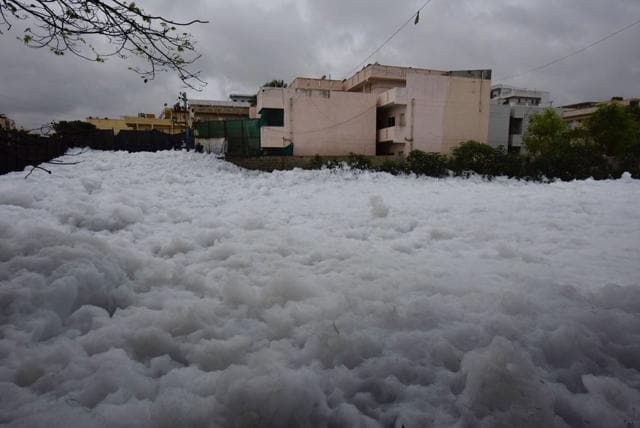The Looming Environmental Disaster; Toxic Foam Plagues Hyderabad’s Waterbodies; Why Are Indian Cities Like Hyderabad And Bengaluru Under Siege Year After Year?
India's cities are grappling with a recurring environmental nightmare, one that poses grave health hazards and stresses the apparent laxity of municipal authorities and governments. Like many urban centers in the country, Hyderabad has recently witnessed the emergence of toxic foam in its streets, a dire consequence of industrial pollution mixing with rainwater and sewage. What are the reasons behind these hazardous episodes, their impact on public health, and the concerning inaction on the part of authorities? Additionally, it raises crucial questions about the utilization of public funds meant for environmental protection and the upkeep of these cities. The health of citizens and the environment's well-being hang in the balance, as Hyderabad's struggle with toxic foam epitomizes cities like Bengaluru and their recurring challenges.

The estimated population of Hyderabad is approximately 10 million, and the estimated population of Bangalore (Bengaluru) is about 12 million, yet year after year, these two cities in India grapple with hazardous episodes of environmental degradation, causing severe health concerns for their residents.
Hyderabad has been recently plagued by a grave environmental hazard in the form of toxic foam, raising questions about municipal negligence, government inaction, and the fate of public funds.
Hyderabad’s Ongoing Battle with Toxic Foam
In a distressing incident following heavy rains, a thick layer of chemical foam emerged on the streets of Shirdi Nagar and Dharani Nagar in the Kukatpally area of Hyderabad. The foam, which caused significant inconvenience to locals, was a result of rainwater reacting with chemical waste from nearby industries, mixing with the sewer passing beside residential colonies.
The situation in Hyderabad mirrors similar incidents in other cities like Bengaluru, where lakes such as Bellandur and Varthur became infamous for emitting toxic foam.
The Laxity of Municipalities and Governments
The alarming rise in pollutants pouring into water bodies like Hyderabad’s Ramakrishnapuram Lake has been a cause for grave concern among residents.
Despite the potential health risks and environmental damage, municipal authorities and government bodies have been accused of precious little action to address the issue.
Hence, residents are left questioning where the money allocated for environmental protection and pollution control is being spent. The lack of transparency and accountability in the utilization of public funds deepens the frustration of those directly affected by these environmental disasters.

The Alarming Parallels with Bengaluru’s Bellandur Lake
Experts warn that if the pollution levels continue to rise unchecked, Hyderabad’s Ramakrishnapuram Lake could suffer the same fate as Bengaluru’s Bellandur Lake, which famously burst into flames in February of a previous year; this recurring phenomenon in Bengaluru shows us the dire consequences of environmental negligence.
A Plea for Action
Despite the grave health issues and environmental concerns arising from these hazardous episodes, officials from bodies like the Pollution Control Board and the Telangana State Groundwater Directorate have remained unresponsive. Thus, the lack of engagement from these authorities raises questions about their commitment to safeguarding the environment and public health.
Health Hazards Extend to Food and Agriculture
The repercussions of Hyderabad’s recurring environmental crises extend beyond the immediate threat of toxic foam. As highlighted by residents, the contamination of water sources poses a significant risk to agriculture in the region.
Crops irrigated with polluted water can absorb harmful chemicals and pollutants, potentially producing hazardous food products, thus further exacerbating health concerns for the residents who rely on locally grown produce.
The proximity of the polluted Ramakrishnapuram Lake to markets like Rythu Bazaar raises valid concerns about the safety of fruits and vegetables available to the public. Shoppers, already burdened by the presence of toxic foam in their neighborhoods, now have to grapple with uncertainty about the safety of the food they consume.
Government Negligence Amplifies the Crisis
The concerning aspect of these recurring environmental disasters is the apparent negligence on the part of municipal authorities and government bodies. Despite mounting evidence of pollution and health hazards, there has been a persistent lack of urgency in addressing the root causes and mitigating the risks, and this negligence is not limited to Hyderabad alone but is seen as a nationwide issue.
Questions arise about the allocation of funds meant for environmental protection and the efficacy of existing pollution control measures; the lack of transparency in fund utilization, combined with a lackluster response to ecological crises, raises suspicions about where taxpayer money is being directed.
A Call for Immediate Action
In light of the increasing health risks and environmental damage caused by such hazardous episodes, it becomes imperative for governments at all levels to prioritize environmental protection and public health.
The existing regulatory frameworks must be enforced rigorously to hold industries accountable for their contribution to pollution. Moreover, investment in water treatment facilities and wastewater management infrastructure is urgently required to prevent the mixing of chemical waste with residential sewer systems.
At the same time, public awareness campaigns on the risks associated with pollution and the importance of responsible industrial practices also need to play a pivotal role in addressing the issue at its core, and they must voice their concerns openly and urgently to compel the responsible authorities to take adequate action on a critical basis.
The Last Bit, the toxic foam crisis in Hyderabad, is not merely an isolated incident but a glaring example of the broader environmental challenges faced by Indian cities.
The potential health hazards posed by contaminated food and agricultural products, combined with governmental negligence, demand immediate attention and action.
As Hyderabad contends with toxic foam, authorities must not only address the immediate crisis but also enact strict regulations, enforce existing pollution control measures, and invest in sustainable wastewater management systems to secure the well-being of its residents.
The estimated millions residing in Hyderabad, and indeed in other Indian cities like Bangalore, deserve a clean and safe environment.



